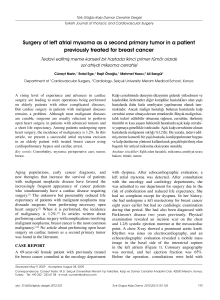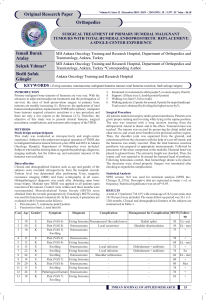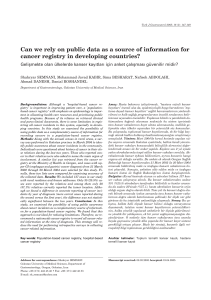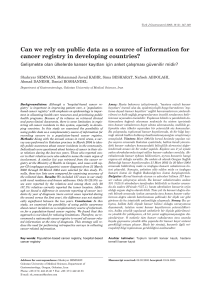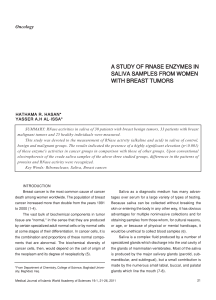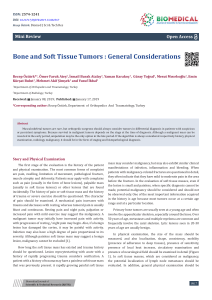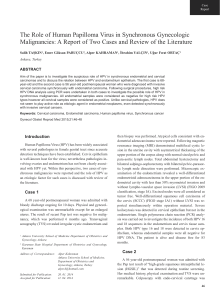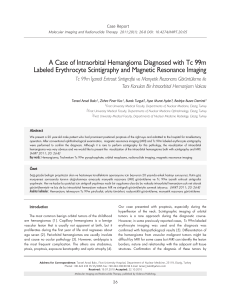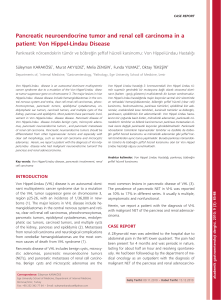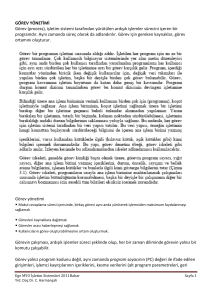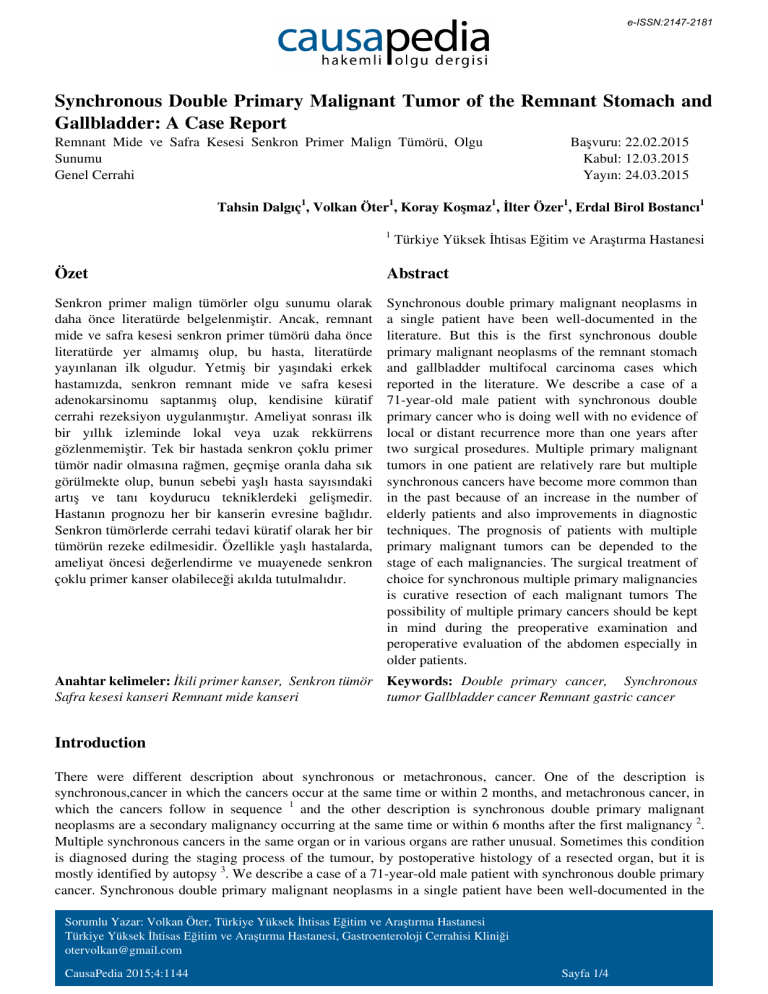
e-ISSN:2147-2181
Synchronous Double Primary Malignant Tumor of the Remnant Stomach and
Gallbladder: A Case Report
Remnant Mide ve Safra Kesesi Senkron Primer Malign Tümörü, Olgu
Sunumu
Genel Cerrahi
Başvuru: 22.02.2015
Kabul: 12.03.2015
Yayın: 24.03.2015
Tahsin Dalgıç1, Volkan Öter1, Koray Koşmaz1, İlter Özer1, Erdal Birol Bostancı1
1
Türkiye Yüksek İhtisas Eğitim ve Araştırma Hastanesi
Özet
Abstract
Senkron primer malign tümörler olgu sunumu olarak
daha önce literatürde belgelenmiştir. Ancak, remnant
mide ve safra kesesi senkron primer tümörü daha önce
literatürde yer almamış olup, bu hasta, literatürde
yayınlanan ilk olgudur. Yetmiş bir yaşındaki erkek
hastamızda, senkron remnant mide ve safra kesesi
adenokarsinomu saptanmış olup, kendisine küratif
cerrahi rezeksiyon uygulanmıştır. Ameliyat sonrası ilk
bir yıllık izleminde lokal veya uzak rekkürrens
gözlenmemiştir. Tek bir hastada senkron çoklu primer
tümör nadir olmasına rağmen, geçmişe oranla daha sık
görülmekte olup, bunun sebebi yaşlı hasta sayısındaki
artış ve tanı koydurucu tekniklerdeki gelişmedir.
Hastanın prognozu her bir kanserin evresine bağlıdır.
Senkron tümörlerde cerrahi tedavi küratif olarak her bir
tümörün rezeke edilmesidir. Özellikle yaşlı hastalarda,
ameliyat öncesi değerlendirme ve muayenede senkron
çoklu primer kanser olabileceği akılda tutulmalıdır.
Synchronous double primary malignant neoplasms in
a single patient have been well-documented in the
literature. But this is the first synchronous double
primary malignant neoplasms of the remnant stomach
and gallbladder multifocal carcinoma cases which
reported in the literature. We describe a case of a
71-year-old male patient with synchronous double
primary cancer who is doing well with no evidence of
local or distant recurrence more than one years after
two surgical prosedures. Multiple primary malignant
tumors in one patient are relatively rare but multiple
synchronous cancers have become more common than
in the past because of an increase in the number of
elderly patients and also improvements in diagnostic
techniques. The prognosis of patients with multiple
primary malignant tumors can be depended to the
stage of each malignancies. The surgical treatment of
choice for synchronous multiple primary malignancies
is curative resection of each malignant tumors The
possibility of multiple primary cancers should be kept
in mind during the preoperative examination and
peroperative evaluation of the abdomen especially in
older patients.
Anahtar kelimeler: İkili primer kanser, Senkron tümör
Safra kesesi kanseri Remnant mide kanseri
Keywords: Double primary cancer, Synchronous
tumor Gallbladder cancer Remnant gastric cancer
Introduction
There were different description about synchronous or metachronous, cancer. One of the description is
synchronous,cancer in which the cancers occur at the same time or within 2 months, and metachronous cancer, in
which the cancers follow in sequence 1 and the other description is synchronous double primary malignant
neoplasms are a secondary malignancy occurring at the same time or within 6 months after the first malignancy 2.
Multiple synchronous cancers in the same organ or in various organs are rather unusual. Sometimes this condition
is diagnosed during the staging process of the tumour, by postoperative histology of a resected organ, but it is
mostly identified by autopsy 3. We describe a case of a 71-year-old male patient with synchronous double primary
cancer. Synchronous double primary malignant neoplasms in a single patient have been well-documented in the
Sorumlu Yazar: Volkan Öter, Türkiye Yüksek İhtisas Eğitim ve Araştırma Hastanesi
Türkiye Yüksek İhtisas Eğitim ve Araştırma Hastanesi, Gastroenteroloji Cerrahisi Kliniği
[email protected]
CausaPedia 2015;4:1144
Sayfa 1/4
e-ISSN:2147-2181
literature. But this is the first synchronous double primary malignant neoplasms of the remnant stomach and
gallbladder multifocal carcinoma case which is reported in the literature.
Case Report
A 71-year-old man was admitted to our hospital because of gastric ulcer detected routinely during a medical
checkup. His family history was unremarkable and his medical history included a subtotal gastrectomy with
Billroth II anastomosis which had been performed ten years ago because of the peptic ulcus disease. On
admission, vital signs were within normal limits. The patient was in good general health and had no significant
weight loss. Physical examination revealed no significant findings. Complete blood count and serum biochemistry
data on admission showed the following: white blood cell, 8,300/uL; hemoglobin, 10.5 g/dl; hematocrit, 31.3%;
platelet, 148000/mm3; blood; total bilirubin, 0.7 mg/dl; alkaline phosphatase (ALP), 41 IU/l; aspartate
aminotransferase (AST), 23 IU/l; alanine aminotransferase (ALT), 26 IU/l, and amylase 108 IU/l. Viral markers
(HBsAg, anti-HBs, anti-hepatitis C virus, anti HIV) were negative . Tumor marker assays showed alphafetoprotein was 4.7 n/ml (normal 0-8.1), carcinoembryonic antigen (CEA) was 3.2 ng/ml (normal 0-5),
carbohydrate antigen 19-9 (CA 19-9) was 12.8 U/ml (normal 0-37). An ultrasonography scan of the abdomen
showed contracted gallbladder with gallbladder stones and gallbladder wall thickening, suggesting chronic
cholecystitis without any suspicious of an abdominal metastases. Endoscopy of the upper digestive tract revealed
gastric ulcer measuring 2 cm at the posterior wall of the cardia, which was proven to be adenocarcinoma by
biopsy. Thus, the preoperative diagnosis was remnant gastric carcinoma and chronic cholecystitis accompanied
by gallstones. At laparotomy, the gallbladder was contracted and showed wall thickening. The patient underwent
surgical resection of the gallbladder and the total gastrectomy with Roux-en-Y oesophagojejunostomy. The
operative and postoperative course was uneventful. The patient was discharged on postoperative day 9.
Histopathological examination revealed macroscopically, the gastric tumour was located in the cardia of the
stomach on the posterior wall (T3, N1, M0; Stage IIB) and a multifocal tumour was located in the fundus and
corpus of the gallbladder (T2, N0, M0; Stage II). The histopathological diagnosis was moderate- differentiated
adenocarcinoma in the stomach (Figure 1) and well-differentiated papillary adenocarcinoma in the gallbladder
with prominent low and high grade dysplasia response infiltrating the gallbladder wall (Figure 2).
Figure 1
Moderate- differentiated adenocarcinoma in the remnant stomach (Hematoxylin and eosin stain, × 100)
CausaPedia 2015;4:1144
Sayfa 2/4
e-ISSN:2147-2181
Figure 2
Well differentiated adenocarcinoma in the gallbladder with prominent desmoplastic response.(Hematoxylin and
eosin stain, × 40)
Patient underwent to reoperation and resection of the gallbladder bed (liver segments; 4b and 5), cystic duct
remnant, and portal lymph nodes was performed. The histopathological examination for the resected specimen
was normal without any tumor. The patient showed no postoperative complication and was discharged on
postoperative seventh day. Oncology planned adjuvant chemoradiation therapy because the gastric cancer
presented as a T3 N1 M0 lesion with lymphovascular invasion. The patient has been under regular follow-up with
clinical examination and liver function test every three months, with surveillance for tumor markers (AFP,
CA19-9, CEA) and abdominal CT scan being done at 6 months intervals. The patient is doing well with no
evidence of local or distant recurrence more than one years after surgery.
Discussion
Multiple primary malignant tumors in one patient are relatively rare but multiple synchronous cancers have
become more common than in the past because of an increase in the number of elderly patients and also
improvements in diagnostic techniques 4. In reviews of the literature about multiple primary malignant tumors, the
overall incident rate of multiple primary malignancies is between 0.73% and 11.7% 4,5 . Three diagnostic criteria
have been recommended for multiple primary malignanies: 1) each tumor must present definite features of
malignancy, 2) each must be distinct, and 3) the chance of one being a metastasis of the other must be
excluded 6 .In our patient, synchronous two different type of tumors were detected and the malignant features
were histopathologically proven in each tumor. Accordingly a well- differentiated multifocal adenocarcinoma in
gallbladder and moderate- differentiated adenocarcinoma in the remnant stomach were observed in a male patient.
These findings might also support the fact that these two cancers occurred in incidental and synchronous manner
Though the mechanism involved in the development of multiple primary cancer has not been clarified, some
factors such as carcinogenics, heredity, constitution, environmental factors, viruses, radiological and chemical
treatments have been suspected.
The incidence of synchronous and metachronous cancer in gastric cancer patients was 3.4%. Comparing
clinicopathological features between patients with another primary cancer and without, the mean age and the
proportion of early gastric cancer were higher in the patients also diagnosed with another primary cancer 7 . The
prognosis of patients with multiple primary malignant tumors can be depended to the stage of each malignancies.
The surgical treatment of choice for synchronous multiple primary malignancies is curative resection of each
malignant tumors 8,9.
CausaPedia 2015;4:1144
Sayfa 3/4
e-ISSN:2147-2181
In conclusion the possibility of multiple primary cancers should be kept in mind during the preoperative
examination and peroperative evaluation of the abdomen especially in older patients.
References
1. Mushtaque M, Khan PS. Synchronous primary double malignancy involving stomach and hepatic flexure
of colon. A case report. Indian J Cancer. 2014, 51(3): 388-9.
2. Suzuki T, Takahashi H, Yao K. Multiple primary malignancies in the head and neck: a clinical review of
121 patients. Acta Otolaryngol Suppl. 2002; 547:88-92.
3. Debevec L, Cesar R, Kern I. Triple synchronous cancers: a medical and ethical problem. Radiol Oncol.
2007; 41(2): 80-85.
4. Kim JW, et al. Synchronous double primary malignant tumor of the gallbladder and liver: a case report.
World J Surg Oncol. 2011; 9:84-8.
5. Demandante CG, Troyer DA, Miles TP. Multiple primary malignant neoplasms: case report and a
comprehensive review of the literature. Am J Clin Oncol. 2003;26(1):79-83.
6. Warren S, Gates O. Multiple primary malignant tumors: A survey of the literature and a statistical study.
Am J Cancer. 1932; 16:1358-414.
7. Eom BW, et al. Synchronous and metachronous cancers in patients with gastric cancer. J Surgical Oncol.
2008;98:106–10.
8. Tamura M, Shinagawa M, Funaki Y. Synchronous triple early cancers occurring in the stomach, colon and
gallbladder. Asian J Surg. 2003; 26(1):46-8.
9. Yoshino K, et al. Statistical studies on multiple primary cancers including gastric cancers. Gan No
Rinsho. 1984; 30(12 Suppl):1514-23.
CausaPedia 2015;4:1144
Powered by TCPDF (www.tcpdf.org)
Sayfa 4/4

